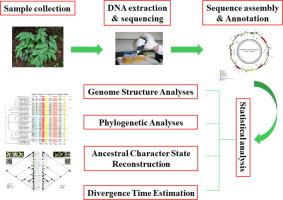Journal of Advanced Research ( IF 11.4 ) Pub Date : 2021-06-30 , DOI: 10.1016/j.jare.2021.06.020 Mengyue Guo 1, 2 , Xiaohui Pang 1, 2 , Yanqin Xu 3 , Wenjun Jiang 1, 2 , Baosheng Liao 4 , Jingsheng Yu 1, 2 , Jiang Xu 4 , Jingyuan Song 1, 2 , Shilin Chen 4

|
Introduction
Epimedium L., the largest herbaceous genus of Berberidaceae, is one of the most taxonomically difficult representatives. The classification and phylogenetic relationships within Epimedium are controversial and unresolved.
Objectives
For the first time, we systematically studied the phylogeny and evolution of Epimedium based on plastid genome (plastome) data for better understanding this enigmatic genus.
Methods
We explored the molecular phylogeny, assessed the infrageneric classification, estimated the divergence times, and inferred the ancestral states for flower traits of Epimedium based on 45 plastomes from 32 species.
Results
The Epimedium plastome length ranged from 156,635 bp to 159,956 bp. Four types of plastome organization with different inverted repeat boundary changes were identified. Phylogenetic analysis revealed a strong support for the sister relationship of sect. Macroceras and sect. Diphyllon but did not provide a distinct route for petal evolution in sect. Diphyllon. Disharmony between phylogenetic relationships and traditional classification of sect. Diphyllon was observed. Results from divergence time analysis showed that Epimedium diverged in the early Pleistocene (~2.11 Ma, 95% HPD = 1.88–2.35 Ma). Ancestral character state reconstructions indicated transitions from long spur (large-flowered group) to other petal types (small-flowered group) in Epimedium.
Conclusion
These findings provide new insights into the relationships among Epimedium species and pave the way for better elucidation of the classification and evolution of this genus.
中文翻译:

质体基因组数据为淫羊藿属的系统发育和进化提供了新的见解
介绍
淫羊藿是小檗科最大的草本属,是分类学上最难的代表之一。淫羊藿内部的分类和系统发育关系存在争议且尚未解决。
目标
我们首次基于质体基因组(plastome)数据系统地研究了淫羊藿的系统发育和进化,以更好地了解这个神秘的属。
方法
我们探索了分子系统发育,评估了属下分类,估计了分歧时间,并基于来自 32 个物种的 45 个质体推断了淫羊藿花性状的祖先状态。
结果
淫羊藿质体长度范围为 156,635 bp 至 159,956 bp。确定了四种类型的具有不同反向重复边界变化的塑性体组织。系统发育分析揭示了对教派姐妹关系的有力支持。Macroceras和教派。Diphyllon,但没有为教派中的花瓣进化提供独特的途径。狄菲龙。系统发育关系与传统宗派分类的不和谐。观察到Diphyllon。发散时间分析结果表明,淫羊藿在更新世早期(~2.11 Ma,95% HPD = 1.88-2.35 Ma)发散。祖先特征状态重建表明淫羊藿中从长刺(大花组)到其他花瓣类型(小花组)的转变。
结论
这些发现为淫羊藿物种之间的关系提供了新的见解,并为更好地阐明该属的分类和进化铺平了道路。











































 京公网安备 11010802027423号
京公网安备 11010802027423号